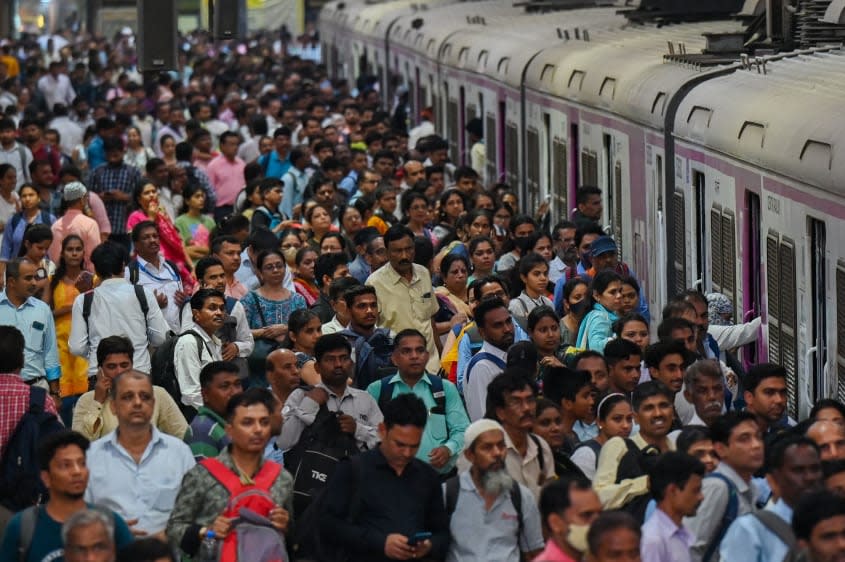Is India's population boom a blessing or a curse?

- Oops!Something went wrong.Please try again later.
India's population, more than 1.4 billion, has surpassed that of mainland China, new United Nations data released this week showed. By summer, it will have about 2.9 million more people than the mainland and Hong Kong combined, according to the U.N. Population Fund's 2023 "State of World Population Report." China's aging population — a "hangover" from its decades-long one-child policy, according to The New York Times — fell last year for the first time in six decades, and it is expected to keep declining and finish the century at less than half its current level. India's population is projected to keep growing for decades. It has increased 1.2 percent a year, on average, since 2011. That was down from 1.7 percent in the previous decade.
India recently overtook the United Kingdom, its former colonizing power, as the world's fifth-largest economy. Global corporations see it as a huge market — Apple just opened its first store there in a push to sell more iPhones — and a manufacturing powerhouse that offers an alternative to China, after that country's COVID lockdowns disrupted supply chains that were overly dependent on its goods. Many leading business and political figures see India's increasing numbers as a blessing that will improve its fortunes and increase its global political and economic power.
But a public survey by UNFPA for the 2023 report found that the most common opinion in the country was that the country's population "was too large and fertility rates were too high." India's demographic changes are fueling the second largest rural-to-urban migration in human history, as masses move to cities desperately seeking work. In the financial hub of Mumbai recently, police with batons recently had to control crowds as 650,000 applicants came seeking one of 8,000 open positions on the police force. "Experts say that India's new status highlights its demographic dividend as the nation with the largest number of young workers," the BBC notes, "but also its biggest challenge: creating enough jobs for them."
What do the commentators say?
India's economy is growing, but has never managed the kind of "transformative growth through export-driven manufacturing" that made China a powerhouse, said Mujib Mashal and Alex Travelli in The New York Times. Extreme poverty has plummeted, but a third of India's children are still malnourished. Making $300 a month puts you in the top 10 percent of earners. India has never been able to create enough jobs for new workers entering the workforce. The country must "somehow produce 90 million new jobs before 2030, outside agriculture to keep employment rates steady," and it has long fallen short of that pace. One of the first things it has to do is beef up its infrastructure, which is far behind China's, to attract the international investment it needs so more people can earn a paycheck.
India has the world's largest population of young people — 254 million between ages 15 and 24, said Amrit Dhillon and Didi Tang in The Times (U.K.). This growing workforce could drive economic growth, but it could also become "a source of unrest and instability if employment opportunities are not adequate." And that's just one of the government's potential problems. A recent heatwave overburdened the power grid as people "turned on air-conditioners and fans." And "providing clean drinking water is already a struggle," with 70 percent of the country's surface water unsafe for human consumption. The government of Prime Minister Narendra Modi is touting India's new status as a sign it's a rising superpower, but it's not clear how the government plans to "house, feed, clothe, educate, and employ" all these people.
India has the workers it needs to become an economic powerhouse, said Amish Mehta in The Indian Express. China and many wealthy nations have aging populations without enough young workers to provide for them. Young people in their prime working years account for 67 percent of India's population. It is "the quality" and training of India's workforce "that is holding it back." The country will have to expand its educational opportunities to capitalize on India's advantages. Just one in five Indian women have formal jobs, and women's labor force participation is falling. That trend "will have to be reversed through employment policies and investing in the health and education of women." Increasing the participation of women in the workforce could add 1.5 percent to India's economic output, according to the World Bank.
What next?
Prime Minister Narendra Modi "gets high marks for helping modernize India's economy," said Andres Oppenheimer in The Miami Herald, but his "growing abuse of power" could ruin everything. Modi is "increasingly intimidating independent media and has used a loyal judiciary to ban opposition leaders." A court ousted opposition leader Rahul Gandhi, Modi's main political rival, just last month for making a joke that Modi had the same last name as two criminals who were in the news. Modi's excesses are "dangerous," because "unlike in China, India's recent progress has been partly due to its democratic stability." If Modi turns into "a full-blown elected autocrat," he could derail India's economic growth "by favoritism, corruption, and skepticism about its future. But if he somehow manages to control his authoritarian instincts, India is likely to become the world's new economic success story."
You may also like
Texas Senate approves bills requiring 10 Commandments in K-12 classrooms, Bible time in school
The U.S. and China want to 'decouple' their economies. Is it possible?
Ice sheets in Greenland and Antarctica are melting at a 'disastrous' pace

